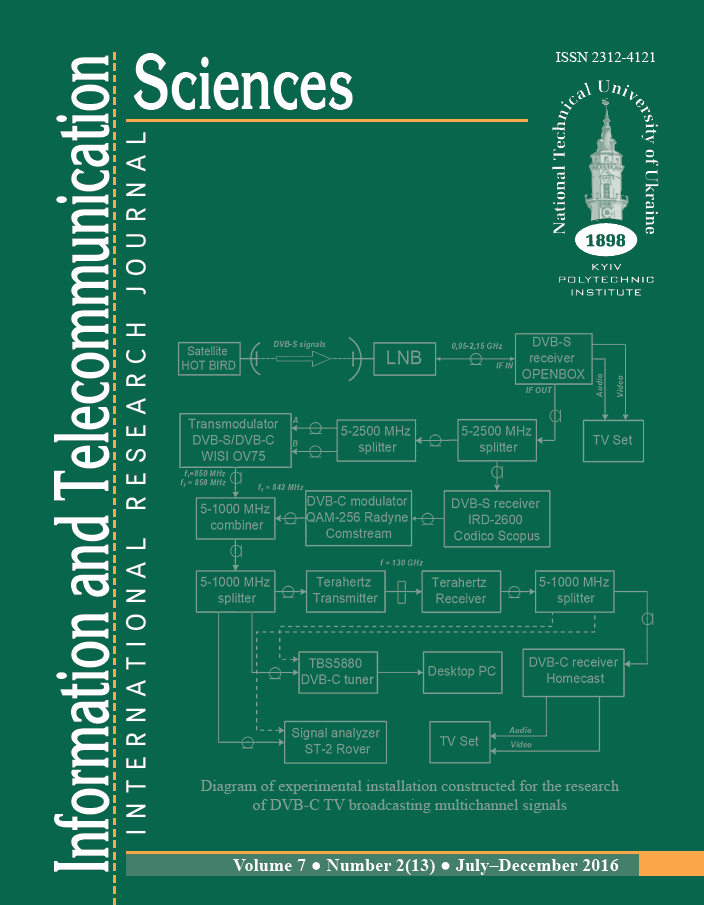INFLUENCE OF CRITICAL CURRENT AND PARAMETERS OF JOSEPHSON JUNCTION ON FREQUENCY STABILITY OF OSCILLATOR
DOI:
https://doi.org/10.20535/2411-2976.22016.54-61Keywords:
superconductors, Josephson junctions, generation linewidth, superconducting generators, frequency-pulse coded devicesAbstract
Background. One of the important characteristics of generators based on Josephson junctions is the power spectral density of phase noises. A number of theoretical and experimental studies showed the spectral shape of generation line is Lorentzian and its width is tens or even hundreds of megahertz. Such form of generation line and its relatively large width complicate usage of JJ in high sensitivity receivers and digital radio engineering devices with frequency-pulse coding of information.
Objective. Problem of investigation the possibility to reduce generation linewidth and increase an output power is of current interest. In this context, the aim of this work is to study the dependence of Josephson junction generation linewidth from its geometrical dimensions and critical current.
Methods. This article was written by means of usage the operator calculation method and mathematical analysis to construct mathematical models and obtain graphical dependencies.
Results. Studies showed the generation linewidth decreases with an increase of Josephson junction width due to reduction in differential resistance of junctions. A magnification of critical current value leads to enlargement of generation linewidth since current of both normal electrons and Cooper pairs grows and this dependence is linear.
Conclusions. The analytical dependence of Josephson junction generation linewidth from its geometrical dimensions and currents of normal electrons and Cooper pairs were first obtained. Comparison of obtained dependencies with experimental results described in other works confirmed an authenticity of developed mathematical models.
References
V. M. Kychak, Synthesis of the Frequency-Pulse Elements of Digital Equipment. Monograph. Vinnytsya, UA: UNIVERSUM-Vinnytsya, 2005.
M. Y. Torgashin, "Development and research of Josephson terahertz generator based on the distributed tunnel junctions," Ph.D. dissertation.
Moscow, RU: Institute of Radio-engineering and Electronics by the Russian Academy of Science, 2013.
L. V. Filippenko, "Integrated Superconducting Receiving Structures Based on High-Quality Tunnel Junctions," Ph.D. dissertation. Moscow,
RU: Institute of Radio-engineering and Electronics by the Russian Academy of Science, 2009.
V. M. Korsunskiy and I. D. Voytovich, Nanoelectronic element base of informatics. Moscow, RU: BINOMIAL. Knowledge Lab, 2013.
G. Bortnik and M. Vasylkivskyj, "Phase jitter estimation in radio channels of telecommunication systems," TCSET’2012, p. 307, February 2012.
A. V. Arzumanov, "Multi-element synchronous Josephson structures," Ph.D. dissertation. Moscow, RU: Lomonosov Moscow State University, 2007.
M. J. Buckingham, Noise in electronic devices and systems. New York, US: Halsted Press, 1983.
Kulik I. O. and Yanson I. K., Josephson effect in superconducting tunnel structures. Moscow, RU: Mir, 1970.
Downloads
How to Cite
Issue
Section
License
The ownership of copyright remains with the Authors.
Authors may use their own material in other publications provided that the Journal is acknowledged as the original place of publication and National Technical University of Ukraine “Igor Sikorsky Kyiv Polytechnic Institute” as the Publisher.
ITS articles are published under Creative Commons licence:
- Authors retain copyright and grant the journal right of first publication with the work simultaneously licensed under CC BY 4.0that allows others to share the work with an acknowledgement of the work's authorship and initial publication in this journal.
- Authors are able to enter into separate, additional contractual arrangements for the non-exclusive distribution of the journal's published version of the work (e.g., post it to an institutional repository or publish it in a book), with an acknowledgement of its initial publication in this journal.
- Authors are permitted and encouraged to post their work online (e.g., in institutional repositories or on their website) prior to and during the submission process, as it can lead to productive exchanges, as well as earlier and greater citation of published work.

